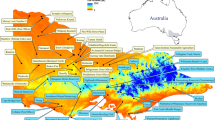Abstract
The present work employs a genetic algorithm to carry out wave height forecasting in the Bay of Bengal. The use of empirical orthogonal function analysis allows the spatial extending of the forecast to the entire basin. The chaotic nature of the process limits the horizon of usable forecasts to 48 h in advance. Statistical evaluation of the quality of forecast leads to encouraging results. A major advantage of this method is that, once the forecast equations are derived, they can be used directly without the necessity of having a numerical wave model as an intermediate step.







Similar content being viewed by others
References
Abarbanel HDI (1993) The analysis of observed chaotic data in physical systems. Revs Mod Phys 65:1331–1392
Alvarez A (2003) Performance of satellite based ocean forecasting (SOFT) system: a study in the Adriatic Sea. J Atmos Ocean Technol 20:717–729
Alvarez A, Lopez C, Riera M, Hernandez-Garcia E, Tintore J (2000) Forecasting the SST space-time variability of the Alboran Sea with genetic algorithms. Geophys Res Lett 27:2709–2712. doi:10.1029/1999GL011226
Alvarez A, Orfila A, Tintore J (2001) DARWIN: an evolutionary program for nonlinear modeling of chaotic time series. Comput Phys Commun 136:334–349
Alvarez A, Orfila A, Tintore J (2004) Real-time forecasting at weekly timescales of the SST and SLA of the Ligurian Sea with a satellite based ocean forecasting (SOFT) system. J Geophy Res 109:1–11. doi:10.1029/2003JC001929
Basu S, Sarkar A, Satheesan K, Kishtawal CM (2005) Predicting wave heights in the north Indian Ocean using genetic algorithm. Geophys Res Lett 32:L17608. doi:10.1029/2005GL023697
Basu S, Sharma R, Agarwal N, Kumar R, Sarkar A (2009) Forecasting of scatterometer derived wind fields in the north Indian Ocean with a data-adaptive approach. J Geophys Res 114:C09004. doi:10.1029/2008JC005201
Canellas B, Balle S, Tintore J, Orfila A (2010) Wave height prediction in the Western Mediterranean using genetic algorithms. Ocean Eng 37:742–748. doi:10.1016/j.oceaneng.2010.02.006
George S, Sharma R, Basu S, Sarkar A (2011) Prediction of sea level anomaly in the Arabian Sea using genetic algorithm. Int J Ocean Climate Syst 2:55–59
Gunther H, Hasselmann K, Janssen PAEM (1992) Report No.4, The WAM Model Cycle 4, Hamburg
Jain P, Deo MC, Latha G, Rajendran V (2011) Real time wave forecasting using wind time history and numerical model. Ocean Model 36:26–39
Mike 21 User’s Manual (2007) Danish Hydraulics Institute, Denmark
Neetu, Sharma R, Basu S, Sarkar A, Pal PK (2011) Data adaptive prediction of sea surface temperature in the Arabian Sea. IEEE Geosci Rem Sens Lett 8:9–13
Prasad Kumar B, Kalra R, Dube SK, Sinha PC, Rao AD (2004) Sea State hindcast with ECMWF data using a spectral wave model for typical monsoon months. Nat Hazards 31:537–548
Preseindorfer RW (1988) Principal component analysis in meteorology and oceanography. Dev Atmos Sci 107:426
Sharma R, Sarkar A, Agarwal N, Kumar R, Basu S (2007a) A new technique for forecasting surface wind field from scatterometer observations: a case study for the Arabian Sea. IEEE Trans Geosci Remote Sens 45:613–619. doi:10.1109/TGRS.2006.888093
Sharma R, Sarkar A, Agarwal N, Kumar R, Basu S (2007b) Predicting wind field in the Bay of Bengal from scatterometer observations using genetic algorithm. Geophys Res Lett 34:L03603. doi:10.1029/2006GL028288
Takens F (1981) Detecting strange attractors in fluid turbulence. In: Rand D, Young LS (eds) Dynamical systems and turbulence. Lecturer Notes in Mathematics, vol 898, pp 366–381. Springer, New York
WAMDI group (1988) The WAM Model- a third generation ocean prediction model. J Phys Oceanogr 18:1775–1810
Acknowledgments
The authors are indebted to Dr. Alvarez for the GA code used in the study. This study forms part of a project under the Meteorology and Oceanography-2 Program of the Indian Space Research Organization (ISRO), and the first two authors of the study wish to thank ISRO for sponsoring the project.
Author information
Authors and Affiliations
Corresponding author
Appendix
Appendix
We provide below two representative analytical equations for 6 and 48 h ahead forecasting of the first PC of SWH
Here, x(t), w(t), y(t) and z(t) stand for PC1 of SWH, WS, COS, and SIN at time t.
Extension of these notations to the backward time steps is trivial.
Rights and permissions
About this article
Cite this article
Sinha, M., Rao, A.D. & Basu, S. Forecasting space–time variability of wave heights in the Bay of Bengal: a genetic algorithm approach. J Oceanogr 69, 117–128 (2013). https://doi.org/10.1007/s10872-012-0154-4
Received:
Revised:
Accepted:
Published:
Issue Date:
DOI: https://doi.org/10.1007/s10872-012-0154-4




